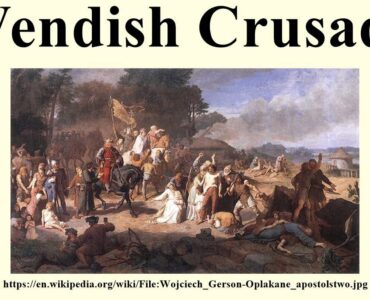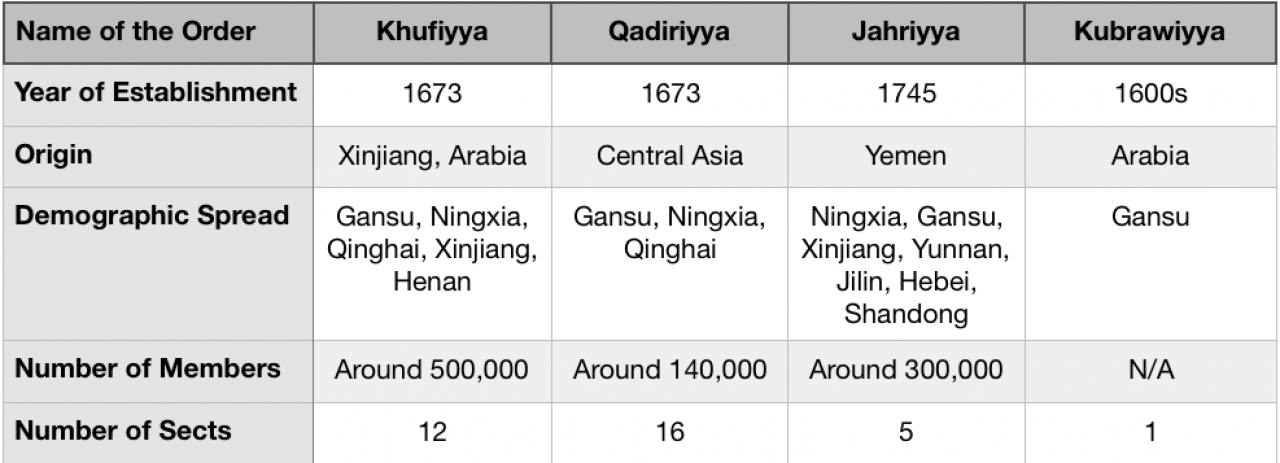
The Lesser Crusades
Children’s Crusade
The Children’s Crusade was a failed popular crusade by European Christians to regain the Holy Land from the Muslims, said to have taken place in 1212. The crusaders left areas of Northern France, led by Stephen of Cloyes, and Germany, led by Nicholas. The traditional narrative is likely conflated from some factual and mythical events which include the visions by a French boy and a German boy, an intention to peacefully convert Muslims in the Holy Land to Christianity, bands of children marching to Italy, and children being sold into slavery. Many children were tricked by merchants and sailed over to what they thought were the holy lands but, in reality, were slave markets.
Accounts
Traditional Accounts
The variants of the long-standing story of the Children’s Crusade have similar themes. A boy begins to preach in either France or Germany, claims that he had been visited by Jesus, who instructed him to lead a Crusade in order to peacefully convert Muslims to Christianity. Through a series of portents and miracles he gains a following of up to 30,000 children. He leads his followers south towards the Mediterranean Sea, in the belief that the sea would part on their arrival, which would allow him and his followers to walk to Jerusalem. This does not happen. The children are sold to two merchants (Hugh the Iron and William of Posqueres), who give free passage on boats to as many of the children as are willing. The pilgrims are then either taken to Tunisia, where they are sold into slavery by the merchants or else die in a shipwreck on San Pietro Island off Sardinia during a gale.
Modern Accounts
According to more recent researchers, there seem to have actually been two movements of people (of all ages) in 1212 in Germany and France. The similarities of the two allowed later chroniclers to combine and embellish the tales.
Nicholas Of Cologne In Germany
In the first movement, Nicholas, an eloquent shepherd from the Rhineland in Germany, tried to lead a group across the Alps and into Italy in the early spring of 1212. Nicholas said that the sea would dry up before them and allow his followers to cross into the Holy Land. Rather than intending to fight the Saracens, he said that the Muslim kingdoms would be defeated when their citizens converted to Catholicism. His disciples went off to preach the call for the “Crusade” across the German lands, and they massed in Cologne after a few weeks. Splitting into two groups, the crowds took different roads through Switzerland. Two out of every three people on the journey died, while many others returned to their homes. About 7,000 arrived in Genoa in late August. They immediately marched to the harbor, expecting the sea to divide before them; when it did not many became bitterly disappointed. A few accused Nicholas of betraying them, while others settled down to wait for God to change his mind, since they believed that it was unthinkable he would not eventually do so. The Genovesey authorities were impressed by the little band, and they offered citizenship to those who wished to settle in their city. Most of the would-be Crusaders took up this opportunity. Nicholas refused to say he was defeated and traveled to Pisa, his movement continuing to break up along the way. He and a few loyal followers continued to the Papal States, where they met Pope Innocent III. The remaining ones departed for Germany after the Pontiff exhorted them to be good and to return home to their families. Nicholas did not survive the second attempt across the Alps; back home his father was arrested and hanged under pressure from angry families whose relatives had perished while following the child.
Some of the most dedicated members of this Crusade were later reported to have wandered to Ancona and Brindisi; none are known to have reached the Holy Land.
Stephen Of Cloyes In France
The second movement was led by a twelve-year-old French shepherd boy named Stephen of Cloyes, who said in June that he bore a letter for the king of France from Jesus. Large gangs of youth around his age were drawn to him, most of whom claimed to possess special gifts of God and thought themselves miracle workers. Attracting a following of over 30,000 adults and children, he went to Saint-Denis, where he was reported to cause miracles. On the orders of Philip II, advised by the University of Paris, the people were implored to return home. Philip himself did not appear impressed, especially since his unexpected visitors were led by a mere child, and refused to take them seriously. Stephen, however, was not dissuaded, and began preaching at a nearby abbey. From Saint-Denis, Stephen traveled around France, spreading his messages as he went, promising to lead charges of Christ to Jerusalem. Although the Church was skeptical, many adults were impressed by his teaching. A few of those who initially joined him possessed his activeness; it is estimated that there were less than half the initial 30,000 remaining, a figure that was shrinking rapidly, rather than growing as perhaps anticipated.
At the end of June 1212, Stephen led his largely juvenile Crusaders from Vendôme to Marseilles. They survived by begging for food, while the vast majority seem to have been disheartened by the hardship of this journey and returned to their families.
Historiography
Sources
According to Peter Raedts, professor in Medieval History at the Radboud University Nijmegen, there are only about 50 sources from the period that talk about the crusade, ranging from a few sentences to half a page. Raedts categorizes the sources into three types depending on when they were written:
Contemporary Sources Written By 1220
Sources written between 1220 and 1250 (the authors could have been alive at the time of the crusade but wrote their memories down later);
Sources written after 1250 by authors who received their information second or third hand
Raedts does not consider the sources after 1250 to be authoritative, and of those before 1250, he considers only about 20 to be authoritative. It is only in the later non-authoritative narratives that a “children’s crusade” is implied by such authors as Vincent of Beauvais, Roger Bacon, Thomas of Cantimpré, Matthew Paris and many others.
Historical Studies
Prior to Raedts’s study of 1977, there had only been a few historical publications researching the Children’s Crusade. The earliest were by the Frenchman G. de Janssens (1891) and the German Reinhold Röhricht (1876). They analyzed the sources but did not analyze the story. American medievalist Dana Carleton Munro (1913–14), according to Raedts, provided the best analysis of the sources to date and was the first to significantly provide a convincingly sober account of the Crusade stripped of legends. Later, J. E. Hansbery (1938–9) published a correction of Munro’s work, but it has since been discredited as based on an unreliable source. German psychiatrist Justus Hecker (1865) did give an original interpretation of the crusade, but it was a polemic about “diseased religious emotionalism” that has since been discredited.
P. Alphandery (1916) first published his ideas about the crusade in 1916 in an article which was later published in book form in 1959. He considered the story of the crusade to be an expression of the medieval cult of the Innocents, as a sort of sacrificial rite in which the Innocents gave themselves up for the good of Christendom; however, he based his ideas on some of the most untrustworthy sources.
Adolf Waas (1956) saw the Children’s Crusade as a manifestation of chivalric piety and as a protest against the glorification of the holy war. H. E. Mayer (1960) further developed Alphandery’s ideas of the Innocents, saying children were the chosen people of God because they were the poorest; recognizing the cult of poverty, he said that “the Children’s Crusade marked both the triumph and the failure of the idea of poverty.” Giovanni Miccoli (1961) was the first to note that the contemporary sources did not portray the participants as children. It was this recognition that undermined all other interpretations, except perhaps that of Norman Cohn (1971) who saw it as a chiliastic movement in which the poor tried to escape the misery of their everyday lives. In his book “Children’s Crusade: Medieval History, Modern Mythistory” Gary Dickson discusses the growing number of “impossiblist” movements across Western Europe at the time. Infamous for their shunning of any form of wealth and refusing to join a monastery, they would travel in groups and rely upon small donations or meals from those who listened to their sermons to survive. Excommunicated by the Pope, they were forced to wander and likely made up a large portion of what is called the “Children’s Crusade.” Peter Raedts’s analysis of 1977 is considered the best source to date to cover the many issues surrounding the Children’s Crusade.
Historians have put the crusade in the context of the role of teenage boys in medieval warfare. Literary scholars have explored its role in the evolution of the tale of the Pied Piper.
Popular Accounts
Beyond the scientific studies there are many popular versions and theories about the Children’s Crusades. Norman Zacour in the survey A History of the Crusades (1962) generally follows Munro’s conclusions, and adds that there was a psychological instability of the age, concluding the Children’s Crusade “remains one of a series of social explosions, through which medieval men and women — and children too — found release.”
Steven Runciman gives an account of the Children’s Crusade in his A History of the Crusades. Raedts notes that “Although he cites Munro’s article in his notes, his narrative is so wild that even the unsophisticated reader might wonder if he had really understood it.” Donald Spoto, in a book about Saint Francis of Assisi, said monks were motivated to call them children, and not wandering poor, because being poor was considered pious and the Church was embarrassed by its wealth in contrast to the poor. This, according to Spoto, began a literary tradition from which the popular legend of children originated. This idea closely follows H. E. Mayer.
Revisionism
The Dutch historian Peter Raedts, in a study published in 1977, was the first to cast doubt on the traditional narrative of these events. Many historians came to believe that they were not (or not primarily) children, but multiple bands of “wandering poor” in Germany and France. This comes in large part from the words “parvuli” or “infantes” found in two accounts of the event from William of Andres and Alberic of Troisfontaines. No other accounts from the time period suggest an age at all, but the connotation with the two words give an entirely separate meaning. Medieval writers often split up a life into four major parts with a variety of age ranges associated to them. The Church then co-opted this classification to a societal coding, with the expression referring to wage workers or laborers who were young and had no inheritance. The “Chronica Regiae Coloniensis,” written in 1213, (a year after the crusade was said to have taken place) refers to crusaders having “left the plows or carts which they were driving, [and] the flocks which they were pasturing,” adding to the idea of it being not “puerti” the age, but “puerti” the societal moniker. A number of them tried to reach the Holy Land but others never intended to do so. Early accounts of events, of which there are many variations told over the centuries, are, according to this theory, largely apocryphal.
Children’s Crusade
802 – 002
https://discerning-Islam.org
Last Updated: 01/2022
See COPYRIGHT information below.



